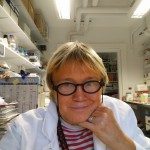Link to Pubmed [PMID] – 28667608
Methods Mol. Biol. 2017;1615:129-142
Experimental determination of membrane protein topology can be achieved using various techniques. Here we present the pho-lac dual reporter system, a simple, convenient, and reliable tool to analyze the topology of membrane proteins in vivo. The system is based on the use of two topological markers with complementary properties, the Escherichia coli β-galactosidase LacZ, which is active in the cytoplasm, and the E. coli alkaline phosphatase PhoA, which is active in the bacterial periplasm. Specifically, in this pho-lac gene system, the reporter molecule is a chimera composed of the mature PhoA that is in frame with the β-galactosidase α-peptide, LacZα. Hence, when targeted to the periplasm, the PhoA-LacZα dual reporter displays high alkaline phosphatase activity but no β-galactosidase activity. Conversely, when located in the cytoplasm, PhoA-LacZα has no phosphatase activity but exhibits high β-galactosidase activity in E. coli cells expressing the ω fragment of LacZ, LacZω (via the α-complementation phenomenon). The dual nature of the PhoA-LacZα reporter allows a simple way to normalize both enzymatic activities to obtain readily interpretable information about the subcellular location of the fusion site between the membrane protein under study and the reporter. In addition, the PhoA-LacZα reporter permits utilization of dual-indicator agar plates to easily discriminate between colonies bearing cytoplasmic fusions, periplasmic fusions, or out-of-frame fusions. In total, the phoA-lacZα fusion reporter approach is a straightforward and rather inexpensive method of characterizing the topology of membrane proteins in vivo.


